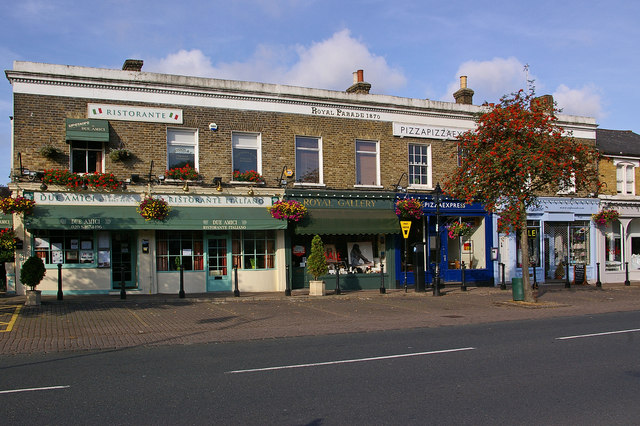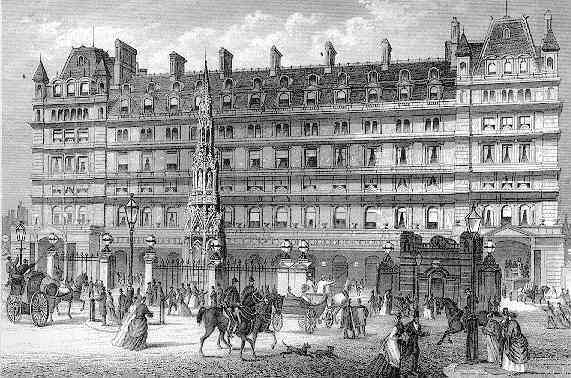|
Eltham Railway Station
Eltham railway station is in the Well Hall area of Eltham, South East London, within the Royal Borough of Greenwich. It is measured from . It is in Travelcard Zone 4. The station is operated by Southeastern. The station has two platforms: platform 1 for services to Central London and platform 2 for Dartford and Barnehurst. History Before 1985, there were two railway stations in Eltham on the Bexleyheath line. Eltham Well Hall (originally just 'Well Hall'), which opened on 1 May 1895, was about to the west of the present-day station on the other side of Well Hall Road. It was one of five stations with wooden buildings and was constructed on the west side of the main road,Extract from 1898 6inch to the mile OS map. Mottingham, Eltham High Street and new (1895) Bexleyheath Line Railway. (map File:Eltham_map_1898.jpg In 1932 the Well Hall buildings were rebuilt. Eltham Park station, which opened 1 May 1908, was about further east of the current station with its main entrance ... [...More Info...] [...Related Items...] OR: [Wikipedia] [Google] [Baidu] |
Well Hall
Well Hall is a place to the north of Eltham in the Royal Borough of Greenwich in southeast London, England, with no present formal boundaries and located east-southeast of Charing Cross.Distance measured using ''''''Nicholson Greater London Street Atlas Comprehensive Edition'' pp.21, 25, 164, 165, 184 and 184 (2003) shows borough boundary, place location, roads, and distance to Charing Cross In the past Well Hall was the grounds of a , and then a |
Southeastern (train Operating Company)
SE Trains Limited, trading as Southeastern, is a train operator, owned by DfT OLR Holdings for the Department for Transport, that took over operating the South Eastern franchise in South East England from privately owned London & South Eastern Railway (which also traded as Southeastern) on 17 October 2021. History In September 2021, the Department for Transport announced it would be terminating the South Eastern franchise operated by Govia-owned Southeastern after revenue declaration discrepancies involving £25million of public money were discovered. SE Trains, as an operator of last resort, took over the franchise on 17 October 2021, for a three-year period until October 2024. Southeastern was one of several train operators impacted by the 2022 United Kingdom railway strike, which was the first national rail strike in the UK for three decades. Its workers were amongst those who participated in industrial action due to a dispute over pay and working conditions. In ... [...More Info...] [...Related Items...] OR: [Wikipedia] [Google] [Baidu] |
Chislehurst
Chislehurst () is a suburban district of south-east London, England, in the London Borough of Bromley. It lies east of Bromley, south-west of Sidcup and north-west of Orpington, south-east of Charing Cross. Before the creation of Greater London in 1965, it was in Kent. History The name "Chislehurst" is derived from the Saxon words ''cisel'', "gravel", and ''hyrst'', "wooded hill". The Walsingham family, including Christopher Marlowe's patron, Sir Thomas Walsingham and Queen Elizabeth I's spymaster, Francis Walsingham, had a home in Scadbury Park, now a nature reserve in which the ruins of the house can still be seen. A water tower used to straddle the road from Chislehurst to Bromley until it was demolished in 1963 as one of the last acts of the Chislehurst and Sidcup UDC. It marked the entrance to the Wythes Estate in Bickley, but its narrow archway meant that double-decker buses were not able to be used on the route. Governance The Chislehurst civil parish formed a ... [...More Info...] [...Related Items...] OR: [Wikipedia] [Google] [Baidu] |
Railway Stations In The Royal Borough Of Greenwich
Rail transport (also known as train transport) is a means of transport that transfers passengers and goods on wheeled vehicles running on rails, which are incorporated in tracks. In contrast to road transport, where the vehicles run on a prepared flat surface, rail vehicles (rolling stock) are directionally guided by the tracks on which they run. Tracks usually consist of steel rails, installed on sleepers (ties) set in ballast, on which the rolling stock, usually fitted with metal wheels, moves. Other variations are also possible, such as "slab track", in which the rails are fastened to a concrete foundation resting on a prepared subsurface. Rolling stock in a rail transport system generally encounters lower frictional resistance than rubber-tyred road vehicles, so passenger and freight cars (carriages and wagons) can be coupled into longer trains. The operation is carried out by a railway company, providing transport between train stations or freight customer facil ... [...More Info...] [...Related Items...] OR: [Wikipedia] [Google] [Baidu] |
Railway Stations In Great Britain Opened In 1895
Rail transport (also known as train transport) is a means of transport that transfers passengers and goods on wheeled vehicles running on rails, which are incorporated in tracks. In contrast to road transport, where the vehicles run on a prepared flat surface, rail vehicles (rolling stock) are directionally guided by the tracks on which they run. Tracks usually consist of steel rails, installed on sleepers (ties) set in ballast, on which the rolling stock, usually fitted with metal wheels, moves. Other variations are also possible, such as "slab track", in which the rails are fastened to a concrete foundation resting on a prepared subsurface. Rolling stock in a rail transport system generally encounters lower frictional resistance than rubber-tyred road vehicles, so passenger and freight cars (carriages and wagons) can be coupled into longer trains. The operation is carried out by a railway company, providing transport between train stations or freight customer facil ... [...More Info...] [...Related Items...] OR: [Wikipedia] [Google] [Baidu] |
Charing Cross Railway Station
Charing Cross railway station (also known as London Charing Cross) is a central London railway terminus between the Strand and Hungerford Bridge in the City of Westminster. It is the terminus of the South Eastern Main Line to Dover via Ashford. All trains are operated by Southeastern, which provides the majority of commuter and regional services to south-east London and Kent. It is connected to Charing Cross Underground station and is near to Embankment Underground station and Embankment Pier. The station was originally opened by the South Eastern Railway in 1864. It takes its name from its proximity to the road junction Charing Cross, the notional "centre of London" from which distances from the city are measured. During the 19th century the station became the main London terminus for continental traffic via boat trains, and served several prestigious international services. It was badly damaged by an engineering accident in 1905 and extensively rebuilt, subsequently beco ... [...More Info...] [...Related Items...] OR: [Wikipedia] [Google] [Baidu] |
Cannon Street Station
Cannon Street station, also known as London Cannon Street, is a central London railway terminus and connected London Underground station in Travelcard zone 1 located on Cannon Street in the City of London and managed by Network Rail. It is one of two London termini of the South Eastern Main Line, the other being , while the Underground station is on the Circle and District lines, between Monument and Mansion House. The station runs services by Southeastern, mostly catering for commuters in southeast London and Kent, with occasional services further into the latter. The station was built on a site of the medieval steelyard, the trading base in England of the Hanseatic League. It was built by the South Eastern Railway in order to have a railway terminal in the City and compete with the rival London, Chatham and Dover Railway. This required a new bridge across the River Thames, which was constructed between 1863 and 1866. The station was initially a stop for continental ser ... [...More Info...] [...Related Items...] OR: [Wikipedia] [Google] [Baidu] |
Electric Multiple Unit
An electric multiple unit or EMU is a multiple-unit train consisting of self-propelled carriages using electricity as the motive power. An EMU requires no separate locomotive, as electric traction motors are incorporated within one or a number of the carriages. An EMU is usually formed of two or more semi-permanently coupled carriages, but electrically powered single-unit railcars are also generally classed as EMUs. The great majority of EMUs are passenger trains, but versions also exist for carrying mail. EMUs are popular on commuter and suburban rail networks around the world due to their fast acceleration and pollution-free operation. Being quieter than diesel multiple units (DMUs) and locomotive-hauled trains, EMUs can operate later at night and more frequently without disturbing nearby residents. In addition, tunnel design for EMU trains is simpler as no provision is needed for exhausting fumes, although retrofitting existing limited-clearance tunnels to accommodate the ex ... [...More Info...] [...Related Items...] OR: [Wikipedia] [Google] [Baidu] |
Woolwich
Woolwich () is a district in southeast London, England, within the Royal Borough of Greenwich. The district's location on the River Thames led to its status as an important naval, military and industrial area; a role that was maintained throughout the 16th to 20th centuries. After several decades of economic hardship and social deprivation, the area now has several large-scale urban renewal projects. Geography Woolwich is situated from Charing Cross. It has a long frontage to the south bank of the Thames river. From the riverside it rises up quickly along the northern slopes of Shooter's Hill towards the common, at and the ancient London–Dover Road, at . The ancient parish of Woolwich, more or less the present-day wards Woolwich Riverside and Woolwich Common, comprises . This included North Woolwich, which is now part of the London Borough of Newham. The ancient parishes of Plumstead and Eltham became part of the civil parish of Woolwich in 1930. Parts of the war ... [...More Info...] [...Related Items...] OR: [Wikipedia] [Google] [Baidu] |
Swanley
Swanley is a town and civil parish in the Sevenoaks District of Kent, England, southeast of central London, adjacent to the Greater London boundary and within the M25 motorway periphery. The population at the 2011 census was 16,226. History In 1066, Swanley only consisted of a few cattle farms, surrounded in oak, sycamore and ash (Fraxinus) woodland. Because Swanley only consisted of a few homesteads, it was not mentioned in the Domesday Book. There is a theory that the placename Swanley developed from the Saxon term 'Swine-ley', "Ley" meaning a clearing in the woods and "swine" meaning pigs. So it has been suggested that it was originally a Saxon pig farm or a stopping place for pigs on the way to the markets in Kent . This later developed into what we now know as Swanley. In the sixth and seventh centuries, there were probably two homesteads. After the Norman Conquest, these portions of land were turned into manors, which were then often divided among the monks at Ghent ... [...More Info...] [...Related Items...] OR: [Wikipedia] [Google] [Baidu] |
Sidcup
Sidcup is an area of south-east London, England, primarily in the London Borough of Bexley. It is south-east of Charing Cross, bordering the London Boroughs of Bromley and Greenwich. Before the creation of Greater London in 1965, it was in the historical county of Kent. The name is thought to be derived from meaning "seat shaped or flat topped hill"; it had its earliest recorded use in 1254. The population of Sidcup, including its neighbourhoods Foots Cray, North Cray, Albany Park, Longlands, Ruxley, Blackfen and Lamorbey, was 43,109 in 2011. History Origins Sidcup originated as a tiny hamlet on the road from Maidstone to London. According to Edward Hasted, "Thomas de Sedcopp was owner of this estate in the 35th year of king Henry VI. .e. in the 1450sas appears by his deed." Hasted described Sidcup in the latter part of the 18th century as "a small street of houses, among which is an inn of much resort", referring to the former Black Horse pub on the high street. ... [...More Info...] [...Related Items...] OR: [Wikipedia] [Google] [Baidu] |







